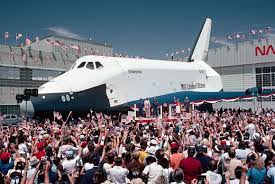On September 17, 1976, a significant milestone in space exploration was achieved with the unveiling of the first space shuttle, named Enterprise. This event marked the beginning of a new era in human spaceflight, as the space shuttle program aimed to revolutionize the way astronauts traveled to and from space. The space shuttle Enterprise was not designed for actual space travel but was instead utilized as a prototype for testing and development purposes. Its primary mission was to conduct a series of approach and landing tests, as well as atmospheric flights to assess the shuttle's aerodynamic capabilities. These tests were crucial in ensuring the safety and viability of future space shuttle missions. The development of the space shuttle program was a collaborative effort between NASA, the United States' space agency, and several aerospace companies. The goal was to create a reusable spacecraft that could transport astronauts and cargo into space and return them safely to Earth. This innovative approach aimed to reduce the cost of space travel and increase the frequency of missions. The space shuttle Enterprise was named after the famous Star Trek spacecraft, reflecting the optimism and excitement surrounding the new era of space exploration. It was unveiled to the public with great anticipation and symbolized the beginning of a new chapter in human spaceflight. The first public appearance of the space shuttle Enterprise took place at the Palmdale, California, manufacturing facilities of Rockwell International, the prime contractor for the space shuttle program. The spacecraft was displayed to an eager crowd as it was rolled out from the hangar, showcasing its sleek design and innovative features. Following its public unveiling, the space shuttle Enterprise underwent a series of rigorous tests and flights to evaluate its performance and capabilities. These tests included captive flights, during which the shuttle was mounted on top of a modified Boeing 747 to simulate the approach and landing phase of a mission. These tests were vital in assessing the shuttle's aerodynamics and handling characteristics. The space shuttle Enterprise also conducted free flights, where it was released from the back of the Boeing 747 and flown by pilots to assess its maneuverability and landing capabilities. These flights provided valuable data that would contribute to the refinement and improvement of subsequent space shuttle models. The successful tests and flights of the space shuttle Enterprise paved the way for the operational space shuttles that would follow. In 1981, the space shuttle Columbia became the first shuttle to launch into space, marking the beginning of regular shuttle missions that would span several decades. Throughout its operational life, the space shuttle program achieved numerous milestones and accomplishments. The shuttles played a crucial role in deploying and repairing satellites, conducting scientific research, and facilitating the construction of the International Space Station. They also transported astronauts from various nations, including the United States, Russia, Japan, and European countries. The legacy of the space shuttle program is undeniable. It revolutionized human spaceflight by introducing reusable spacecraft, which significantly reduced the cost of space missions and increased their frequency. The space shuttle Enterprise, as the pioneer of the program, played a vital role in demonstrating the feasibility and safety of this groundbreaking approach. Today, the space shuttle Enterprise is on display at the Intrepid Sea, Air & Space Museum in New York City, where it continues to inspire and educate visitors about the achievements and possibilities of human space exploration. Its legacy lives on as a symbol of innovation, collaboration, and the relentless pursuit of knowledge beyond the boundaries of Earth.
17 Sept, 1976 First Space Shuttle the Enterprise
